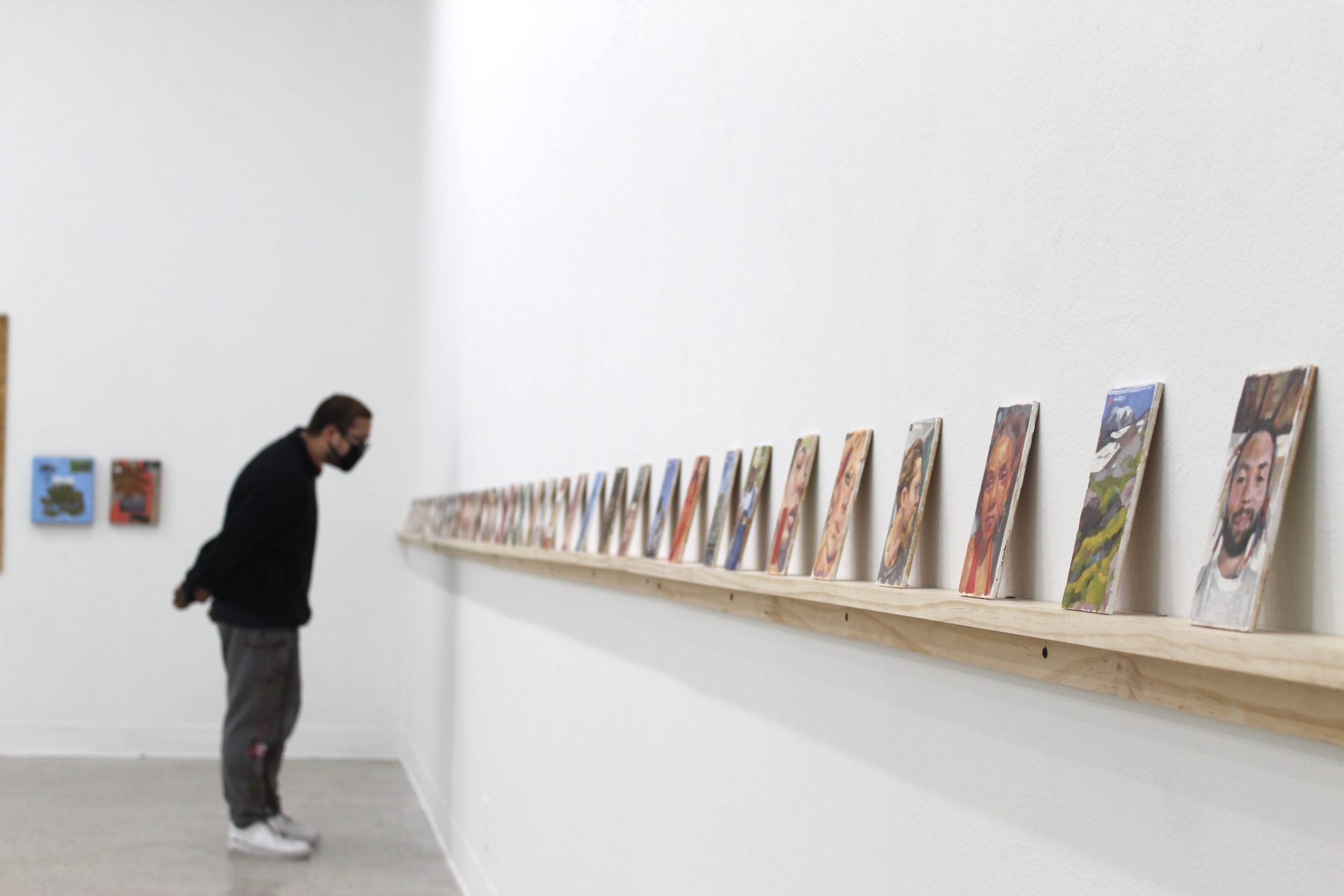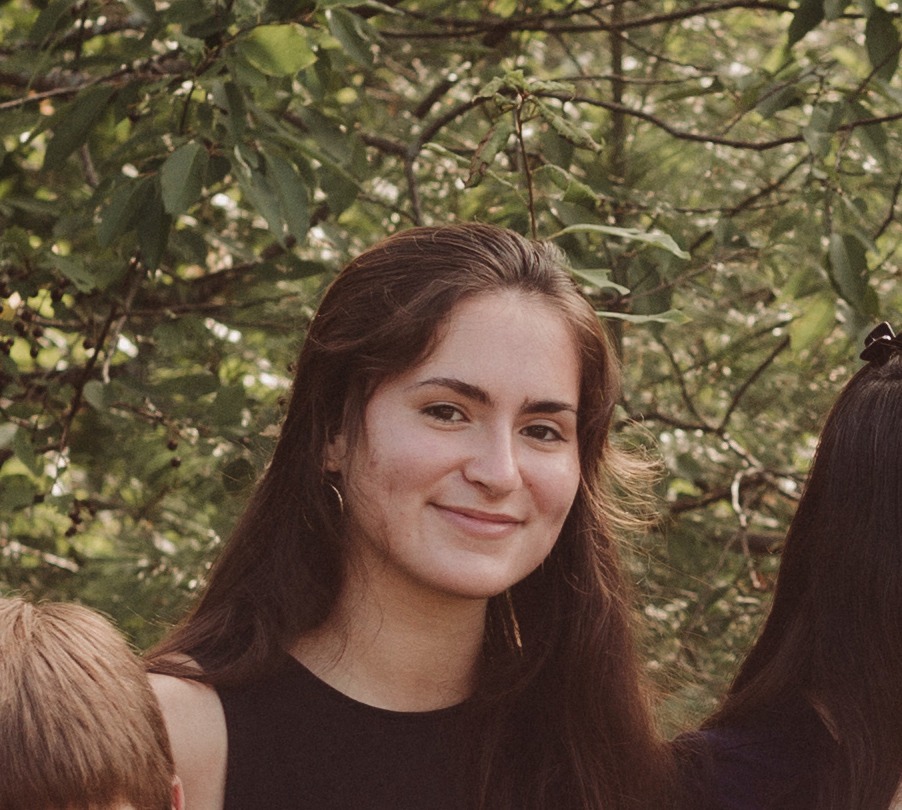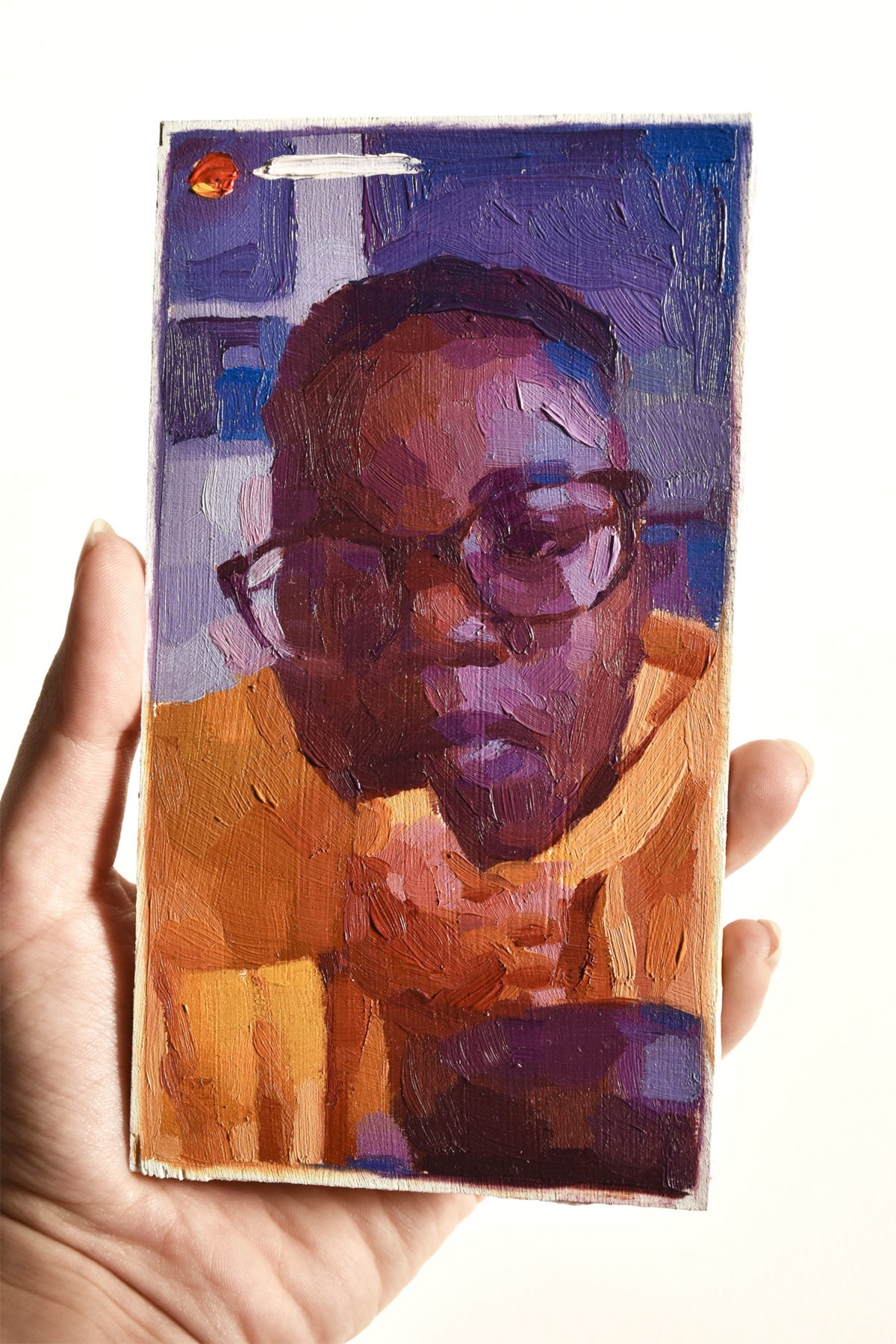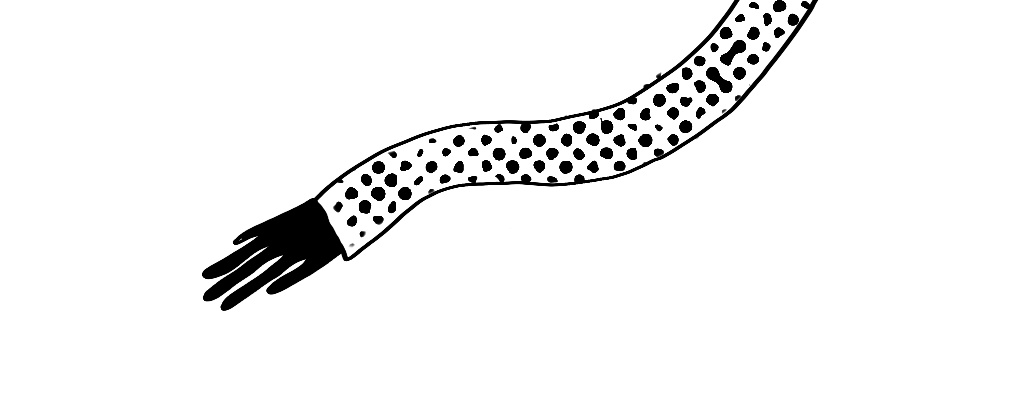Marisa Stratton
We asked special guests to choose a student whose work must be highlighted, whose talents they want to share with the world and whose names we’ll all soon know in Qatar.
Discover The Anderson Gallery Director Chase Westfall's pick!

Interview with Marisa Stratton and Chase Westfall
April 2021
How to maintain that initial impulse in the painting
Who are you, and where are you from?
Marisa Stratton: I’m Marisa Stratton. I’m an Illustration major with a Painting minor at VCUarts. I’m a military brat, so I’m kind of from everywhere. I’ve lived in Florida and Germany and Japan. Lots of places and now Richmond. and I think I’ve definitely found my place here.
What made you follow a career in the creative arts apart from the obvious talent with drawing and painting?
MS: I’ve been trying to figure that out. I think it was just this need to show my appreciation for the things around me. And I think, rendering things, painting things and drawing things was a way for me to process, the beautiful things around me. And I still think I do that today.
I work as an editor for a publication, so I’m very used to the rhythm of making commercial illustrations, but I think I’m most passionate about painting and creating physical things and just engaging with art in a different way.
Chase, as painter and curator. Can you describe her art without necessarily putting her in a box, but for the general audience, that we can understand where she’s going, where she’s from.
Chase Westfall: Sure. In her artist’s statement Marisa describes herself as a traditional painter. Let me see if I can pull that up so I’m not misrepresenting the language that she used. And while I wouldn’t disagree with that, I challenged her yesterday on that, a little bit, because while she is working in this traditional media of oil on panel, there is something very contemporary about her approach.
She hasn’t fetishized, as some painters do, of falling into this trap of trying to paint in an archaic style. Always with their focus backwards towards something that draws them into a kind of tunnel.
Marissa takes cues from them. Leans on that kind of repertoire of traditional materials, but is also open to the ways in which new experiences of light, as suggested by the paintings that she’s doing of the zoom meetings and of Instagram interactions.
There are different kinds of expressions of materiality and value and light. Different kinds of mediation of physicality that happened in those media and in those virtual spaces. And rather than being fixated on the kind of traditional approaches of building light within painting, she really is incredibly intuitive and sensitive to how those new experiences can be.
Rendering things, painting things and drawing things was a way for me to process, the beautiful things around me.
Marisa Stratton
That’s one of things that catches my eye and she’s kind of bold with how she approaches her work. There are, in some of her latest paintings, what I would call, lovingly, really ugly places where the distortions that happen in that media, where the kind of alien hues and tones are produced. I’m looking at myself right now. My body basically looks purple and she finds a way to valorize all of that and own all of that.
I think that’s one of the things that makes the difference in her approach as a painter. It isn’t just about her pursuit of her own excellence. There is a sense of care that is brought into everything, a way of honoring moments. It’s hard to point exactly to what formally gives that kind of sense to it. But when you look at them, when you’ve looked at a lot of painting, as I have, you can just sort of see that those subtle differences in the way that she’s marking and in the way she uses the rendition, the kind of rendering that you care to be cared for and to be present with it.
Will you add something, Marisa?
MS: Oh my gosh. I totally agree. And I’m very flattered about what you say about my painting and all of that. But I agree. I think digital media can be really overwhelming and we’re constantly documenting things and it’s hard to appreciate those moments while you’re in them, because you’re trying to react to them, you know, in zoom calls.
And it’s really draining. There’s so much screen fatigue. It’s hard to draw something really meaningful out of that, but I think sometimes I would just take a screenshot of a meeting and then weeks later I would look at it and be like that’s beautiful. There are so many things going on here. That could look contrived or stuffy, so I want to maintain that initial impulse in the painting, but also still kind of lovingly care for it. I can hold them in my hand. That’s very, very intimate. It creates this closeness between me and the painting. That’s just beautiful. Um, so I agree with everything you said for sure.


I am a representational painter exploring the collective digital experience and its relationship to painting as documentation. How do we ascribe meaning to interactions and experiences that only exist on screens?
In my screen-sized oil paintings sourced from social media posts and web conferences, I transpose the digital into the physical while also initiating deeper and more meaningful connections as a result. When I paint these seemingly inconsequential moments, I am interpreting them in the context of traditional oil painting as a medium of formal portraiture and historical documentation. I also explore ideas of public presentation, image consumption, and consent by manipulating the inherent voyeurism embedded within all modes of digital interaction.
With my work, I return to the idea of portrait painting as a necessary artifact of a relationship, conversation, or experience – with a firm awareness of the digital age. Painting is a way to tether me to the physical world and the people around me, even if that means redefining the ways I experience them.

With my work, I return to the idea of portrait painting as a necessary artifact of a relationship, conversation, or experience – with a firm awareness of the digital age.
Marisa Stratton

Chase Westfall is an artist, musician, and curator. In 2017 he joined Virginia Commonwealth University, Richmond, USA as Curator of Student Exhibitions and Programs where he serves as Director of the Anderson and oversees an evolving program of student and professional exhibitions, including the annual VCUarts MFA Thesis Exhibition. Recent projects include Stone’s Throw: Arte de Sanación, Arte de Resistencia (2020) a survey of contemporary Central American artists, curated with Laura August; Carmen Winant: Fire on World (2019); When the Whirlwind Begins (2019) a student-curated survey of Philadelphia artists; Ron Rege Jr: From the Word of First Thought (2019) co-organized with Dem Passwords, Los Angeles; Daniel Everett and Leah Beeferman: Surface Tension, Surface Tenses (2019); and Caitlin Cherry: Etherpaint (2018).
Westfall received his MFA from the University of Georgia and BFA from the University of Florida, USA. Artist projects include Rachel, Central Connecticut State University, New Britain, CT (2019); Control, Utah Museum of Contemporary Art, Salt Lake City (2018); Resist Evil, Santa Fe Galleries, Santa Fe College, Gainesville, FL (2017); Terror Function, 101/exhibit Gallery, Los Angeles, CA (2015). He was selected as one of 10 Florida artists for the 2017 Florida Prize in Contemporary Art, Orlando Museum of Art, Orlando, USA.

Insight
So, in a single night, I learned how to hang a show just by putting myself in the position to do it. And it was such an amazing experience. I have so many wonderful things to say about VCU people, the students, and this culture. It’s so hard now, because we’re online, but I think we’re still trying to maintain this, this collective love for these spaces and all of that.
Marisa Stratton

The first impression
Chase Westfall: The first impressions were very positive and subsequent impressions have only built on those positive, first impressions she was talking about.
Traveling around as an army brat, I think one of the really powerful lessons that can come from that is that the world is to be met. You need to go out and engage it. If you’re moving from place to place. Then, you know, that wherever you land, you’ve got to go out and shape a community for yourself and just meet the world and that kind of outgoing, uh, hopeful, generative, energy, generous energy. She just brought into everything that she did. We opened the doors to stuff.
In particularly when students like Marisa who had that reciprocity come in and grab those opportunities by the horns. We were so thrilled. With her efforts to take the initiative, to curate exhibitions, to be ambitious in her approach to installing her own artwork.
There was an instance with a recent juried exhibition that she was a participant in, I challenged her to build a large, fairly technically involved, shelf as a display structure for the series of paintings. And she rose to the challenge, executed perfectly, put in a lot of extra hours and labor when she could have just said “I’ll just put them on the wall.”
The installation was just absolutely spellbinding and it ended up being acknowledged as the best in show, by our guest juror. That for me is how those positive beginnings can snowball into something really expansive and exciting and, can be acknowledged and recognized by somebody like Anna Katz, a curator at The Museum of Contemporary Art, Los Angeles. I mean, what an incredible accolade, what incredible feather in your cap to have a curator of that stature acknowledge your efforts and your talents.
Standing out among the local scene
CW: We have an incredible community of students and artists here. There is, I would say a particularly strong impulse towards community here at VCU compared to other schools that I’ve been at. There’s a feeling of familial-like care and connection that, goes beyond what I’ve experienced in other places.
But even within that kind of general culture, Marissa stood out. One of the things that really struck me was seeing the ways that she went to great lengths to support her peers. I can recall several instances where she was really essential in helping me communicate with persons to make sure that certain exhibition opportunities were extended to them.
In one case there was an artist that I couldn’t get a hold of, that we were excited about tracking down and Marisa happened to be a friend of that person and was willing to step in and be the liaison between them and other instances where I’ve seen her helping transport and install her peers work.
I mentioned generosity before: there was the sense that she was always willing to invest in. And that’s something of a general rule in life, when people feel that you’re invested, they’re going to want to meet you, within that relationship and within that space of investment.
I’m just awestruck by her facility and more than facility, the kind of tenderness, the kind of care that, I would be attracted to anyway, but as a painter myself, it just knocked me out.
Chase Westfall
CW: She always put out that energy, it was the most natural thing. It was magnetic for us to be drawn into that kind of sphere of generosity. That’s the kind of sphere of investment that she brought to the table. And of course, and, and I don’t know if you want to include this because I don’t want my bias as a curator to be revealed but, I’m a painter and I am just absolutely in love with her abilities as a painter.
I’m just awestruck by her facility and more than facility, the kind of tenderness, the kind of care that, I would be attracted to anyway, but as a painter myself, it just knocked me out. So, I had a bias towards her from the beginning.
MS: Oh, man, probably the people I’ve met. I feel creating this support system was essential for me to continue working. Right now, it’s hard to work in isolation and it’s hard to critique on zoom. There needs to be something else there in order for us to kind of sustain ourselves. So making sure of putting myself in a place where other people want to approach me and want to create relationships.
It’s so essential for me. And, because I moved around a lot, I think it’s just a survival instinct. I need to have people to work with and engage with in order for myself to grow, in my work, thinking about all the people that have helped me, all these opportunities that wouldn’t have happened if I hadn’t put myself in a position to be approached.
They are definitely the people that are going to sustain me after school; these people I’ve met and the professors, that’s the most important thing. Probably my biggest achievement of all my accolades come from these personal interactions, they’re all at the base.
Everything is built on relationships. I’m having a solo show in June and the person who owns the gallery is my freshmen year drawing professor. So that relationship grew and I wouldn’t be in that situation if I hadn’t fostered a relationship with my drawing professor who I love, he’s an amazing painter. I think all of it at its core, that kind of sustains everything I do.



To her youngself
What would you say to your younger self? Imagine you’ve gone back to when you were 16 or whenever you realize you have to start making decisions.
MS: I think about this a lot, actually. I would just say trust yourself.
I feel like, you know, a lot of my work is based on impulse, just this need to create, and then I act on it. So, I think trusting my instincts and just letting them take me where I need to go is, what’s gotten me here.
Just don’t second guess yourself, you know? I think that’s so important when I think that ‘little me’ would be like in awe of what I’m doing right now. And I think that’s so beautiful.
CW: That’s a good place to be. I want to put out there another, accomplishments of Marisa’s, thus far. Marisa was just selected for the upcoming issue of New American Paintings, which is a major acknowledgement, a major accolade, especially for somebody who’s just finishing undergraduate school.
That’s a big, big deal. So, again, evidence, not that we needed any additional evidence, but evidence of her bright future, not just what she’s accomplished up to this point, but all the things that wait for her
Chase, what do you wish for Marisa?
CW: Oh, man. I feel like she’s in a really good place. She and I had a little bit of a conversation yesterday. I think it wouldn’t be that different from what she’s articulated for herself. If you can find a place where what you’re making, gives you the financial stability that we all want, and need, and brings you into the right kind of spiritual and human relationship with the world around you, then you’ve made it.
So being centered as you move forward is the key thing. And if she can find that place of being centered, that’s the best you could wish for anybody. And my feeling is that she’s on the right path to get there.
The things that she needs to sustain herself professionally will be in place. She’ll have opportunities. She’ll have to grind like everybody does. It might be a few years to where you get that teaching job then a few years before you settle into that rhythm, but it feels almost like an inevitability.
So, what I would hope is that, once she arrives in that place of balance where the material concerns are satisfied, while at the same time putting her in a place where she can continue to grow in empathy and generosity; as she has kind of grown up to this point.
Related Topics
The RAW Talent
2021
